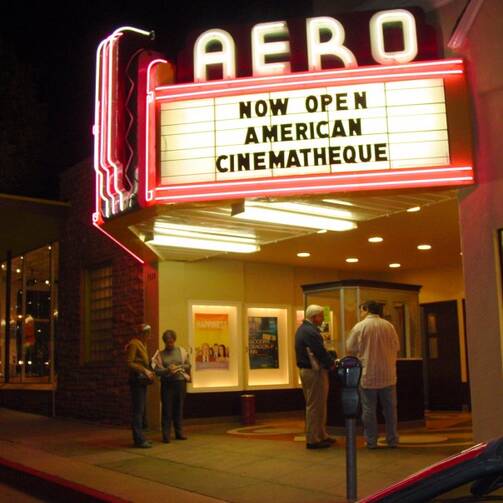When you think of Los Angeles, it’s hard not to think of the movies. It is the cornerstone industry of this city.
And yet, in some significant ways, Los Angeles today is not really a “movie” city. Yes, we all turn up for the latest blockbuster, just like everyone else. And more than anywhere in the United States, the entertainment section of our newspaper is consumed with the business of Hollywood.
But in general, we do not prize cinema to the degree you might expect given its importance here. Like most places around the country, our movie-going landscape has been largely devoured by horrible, ugly box-buildings that charge too much and feel compelled to describe themselves in the testosterone-laced language of sporting venues. And their audiences largely consist of people who talk and behave like they’re still at home. Truly, to not have someone repeatedly checking their phone during a viewing is now the rare exception. And God forbid if you should actually ask someone to stop. Maybe it’s the fact that more and more we each spend so much of our lives independent of one another, communicating only via technology; or maybe it’s akin to that childhood delusion where you think if you’re not looking at someone, they can’t see you. Either way, we just don’t show much respect.
(Then again, the movies have always been one of the few places where we are allowed to make the most disgusting messes and feel completely comfortable leaving it for someone else to clean up. So maybe the fact we’re now texting while others are trying to watch Ryan Reynolds shoot people is inevitable.)
Weirdest of all, though, is the fact that most movies do not stay in L.A. very long. We’re the second biggest city in the country and the clear center of the global film industry, but if your film doesn’t have big box office or good buzz, good luck lasting more than a couple weeks here. And if you’re a foreign film, two weeks is like an extended run. You’re lucky to get a review in the papers.
That’s in comparison to New York, where the most obscure, foreign or independent films can live on for months, and where audiences at a Lincoln Center, Film Forum or until recently the Ziegfeld (R.I.P., you beautiful creature) still greet movies with the hungry, rapt thrill of children attending their first talkie. There’s that silence that descends over such an audience as the lights go down, lush and nourishing. Honestly, I return to New York in part just to soak that in again.
But as I live longer in Los Angeles, I do find myself slowly discovering little corners of life that remain in this arid cinematic desert. I recently heard word of a big-screen showing of Ridley Scott’s uber-classic 1982 dystopia “Blade Runner.” Showing up I found myself in a pretty, far-from-the-tourists part of Santa Monica at a little art deco theatre called the Aero. In this age of -plexes and -stadia and whatever the heck “XD” is, the Aero offers just a single screen of 38’ x 18’ in a gently raked room that seats 425. It opened in 1940, having been built by the Douglas Aircraft Company, a one-time nearby aerospace engineering power—hence the name “Aero”—as a 24-hour movie house to serve employees coming off the production lines. Founder Donald Douglas was a visionary who understood the future reality of commercial air travel long before most did; at its height his company was the fourth largest business in the United States.
Like all movie houses and most long-term small businesses in general, the Aero has faced considerable struggles to stay open over the decades. After its most recent lean years, management was taken over by American Cinematheque, a nonprofit, viewer-supported organization that focuses on classic films, art house productions and film series. Fundraising brought in state of the art projection equipment, all while keeping the price to a ridiculously reasonable $11.00 for an evening show, $7.00 for members.
You don’t buy your particular seat online; you can’t order pizza or a hot dog at concessions (thank God; I don’t know why this is true, but it is: there is nothing more disgusting than sitting next to someone eating smelly food during a movie). And the slope of the room is such that from time to time you find yourself sitting up straighter to see over the head of the person in front of you.
But none of that meant anything when the lights went down and the title credits began over black to Vangelis’ score. It’s almost unheard of today to see a film not by Woody Allen take two or three minutes just to list the names of the actors. Quentin Tarantino’s recent “The Hateful Eight” opens with an entire overture. I found people around me talking all the way through it.
But here, as soon as the credits started, that endangered species of grateful silence descended. We all waited eagerly to be transported to a magical world. And in those moments, I was already there.
Jim McDermott, S.J., a screenwriter, is America’s Los Angeles correspondent. Twitter: @PopCulturPriest.








